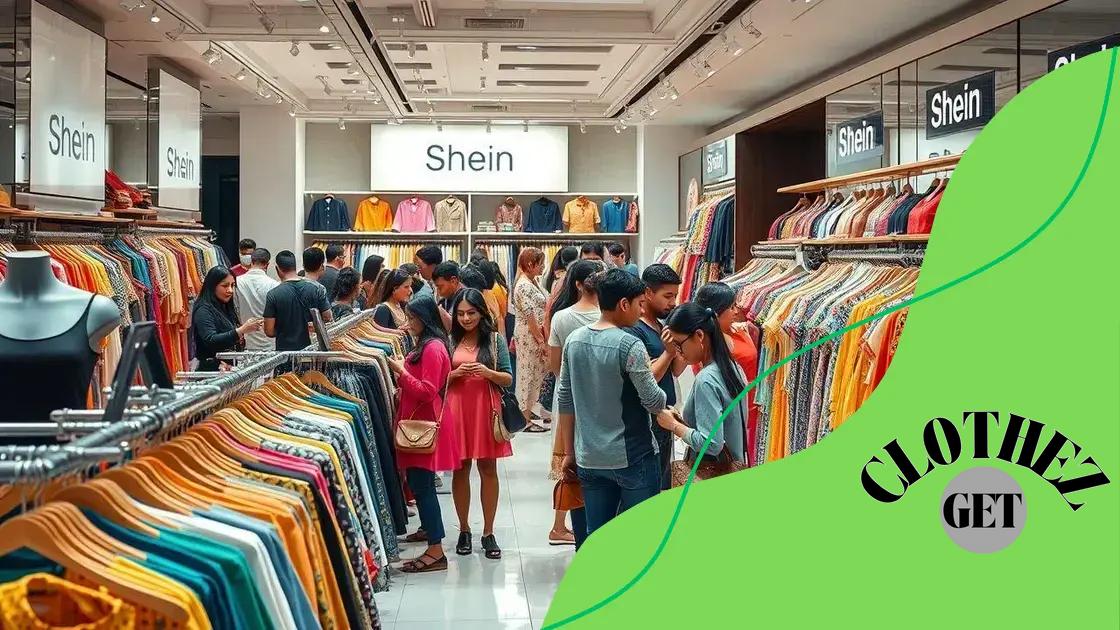Shein’s impact on global fashion retail: a closer look

Shein’s impact on global fashion retail is characterized by rapid production and low pricing, influencing consumer behavior while raising significant sustainability concerns in the industry.
Shein’s impact on global fashion retail is reshaping the way we shop and view trends. But have you ever wondered what effects this phenomenon has on our choices and the industry?
The rise of Shein in fashion retail
The rise of Shein in fashion retail has been nothing short of remarkable. Over the past few years, this brand has exploded onto the scene, changing how we perceive fast fashion.
Originating in China, Shein started as an online retailer focused on affordable women’s apparel. It quickly expanded its reach, becoming popular among younger consumers globally. This surge in popularity can be attributed to many factors including effective marketing strategies and a deep understanding of current trends.
Strategies Behind Shein’s Success
Shein employs a unique business model that allows it to stay ahead in the fast-paced fashion world. Here are some key strategies that contribute to its success:
- Frequent new arrivals based on the latest trends.
- Strong social media presence that engages young shoppers.
- Affordable pricing that appeals to budget-conscious consumers.
- Influencer partnerships that enhance brand visibility and trust.
Shein’s ability to quickly adapt to emerging trends keeps its inventory fresh and exciting. New styles are added daily, drawing in customers who want the latest looks at low prices. The vast selection available encourages frequent visits to their site, leading to higher sales.
Impact on Traditional Retailers
The rapid rise of Shein has significantly impacted traditional retailers. Many established brands are now facing challenges as consumers increasingly turn to online platforms for their shopping needs. Traditional stores often struggle to compete with Shein’s low prices and variety.
Moreover, traditional retailers are reassessing their business models to better align with changing consumer preferences. A major shift towards e-commerce is evident as they seek to replicate the success of fast-fashion brands like Shein.
In summary, the rise of Shein in fashion retail showcases the changing landscape of consumer shopping behavior. Through innovative strategies, Shein not only dominates online sales but continues to challenge traditional retail norms. This creates a dynamic fashion industry where brands must continuously adapt to thrive.
How Shein influences consumer behavior
How Shein influences consumer behavior is a fascinating topic. The brand has changed how many young shoppers approach fashion by making trendy clothing accessible and affordable.
One significant way Shein influences consumers is through its robust online presence. Using social media platforms, Shein connects directly with potential buyers, showcasing new arrivals and popular items. This strategy grabs attention and encourages impulse buying.
Engagement Through Social Media
Shein excels at engaging customers through platforms like Instagram and TikTok. Their posts often feature:
- Influencers wearing Shein clothing.
- Trendy outfit ideas shared by users.
- Promotions and discounts that attract attention.
This active online engagement creates a sense of community among shoppers. People share their Shein hauls and styling tips, making others eager to join in on the experience.
Fast Fashion and Consumer Expectations
Shein’s approach to fast fashion has also reshaped consumer expectations. The constant introduction of new styles means that shoppers are now conditioned to expect a steady stream of fresh options. Many feel a need to keep up with the latest trends, leading to more frequent purchases.
This behavior encourages consumers to view clothing as disposable rather than lasting. With every new drop, buyers feel compelled to refresh their wardrobes, which can contribute to an unsustainable cycle of consumption.
Moreover, the affordability of Shein’s items makes it easy for consumers to justify buying multiple pieces without spending a lot of money. This habit fosters a shopping mentality that prioritizes quantity over quality.
As a result, Shein not only provides options but also shapes how consumers think about their fashion choices. The blend of instant gratification, social influence, and affordability keeps shoppers coming back, proving how powerful Shein’s impact is on consumer behavior.
Sustainability concerns with Shein

Sustainability concerns with Shein have become a hot topic in the fashion industry. As a dominant player in fast fashion, Shein draws attention for its rapid production cycles and low-cost items.
Critics argue that Shein’s model promotes a throwaway culture, where clothing is seen as disposable. The brand’s ability to churn out new styles quickly results in tons of waste, contributing to environmental degradation.
The Environmental Impact of Fast Fashion
Fast fashion brands like Shein often prioritize speed over sustainability. Some of the key environmental issues include:
- High carbon emissions from mass production and shipping.
- Water pollution caused by textile dyeing processes.
- Excessive waste from unsold merchandise.
- Use of non-biodegradable materials in products.
This rapid cycle of consumption not only impacts the planet but also puts pressure on resources, leading to water shortages and loss of biodiversity. As consumers buy more clothing from Shein, the strain on the environment becomes increasingly evident.
Consumer Awareness and Responsibility
As consumers become more aware of environmental issues, many are questioning their purchasing habits. The growing demand for sustainability has led some to call for greater transparency in brands like Shein. Shoppers want to know where and how their clothes are made.
In response, some fast fashion companies are beginning to adopt eco-friendly practices. However, critics argue that these changes aren’t enough to offset the damage done by their current business models. Many consumers are torn between the allure of low prices and the need for sustainable options.
Ultimately, addressing sustainability concerns with Shein requires a collective effort. Brands must prioritize ethical practices, and consumers should make informed choices to support a more sustainable fashion industry. The journey towards sustainability in fashion is ongoing, and understanding the implications of fast fashion is crucial for all shoppers.
Comparing Shein to traditional retailers
Comparing Shein to traditional retailers reveals distinct differences in business models, marketing, and consumer experiences. While both sell clothing, their approaches to supply chains, pricing, and sustainability vary greatly.
Traditionally, retailers have longer production cycles that can take months. In contrast, Shein introduces new styles weekly, allowing it to respond quickly to fashion trends. This speed gives Shein a competitive advantage, especially among young consumers eager for the latest styles.
Price Point Differences
When it comes to pricing, Shein often undercuts traditional retailers. Here are some notable points:
- Shein’s prices can be significantly lower, making fashion accessible to more consumers.
- Traditional retailers often emphasize quality and craftsmanship, which can come with higher price tags.
- Shein uses strategies like flash sales to attract price-sensitive shoppers.
- Many consumers are willing to buy from Shein for trendy items knowing they may not last long.
As a result, shoppers often find themselves weighing quality against cost. While traditional retail emphasizes durability, Shein offers fast, affordable options that cater to current trends.
Consumer Experience and Brand Loyalty
The consumer experience in shopping at Shein differs greatly from traditional retailers as well. Shopping online has become more prevalent, but Shein’s website and app are tailored for quick browsing. Customers find ease in navigating vast collections, often leading to impulse buys.
In contrast, visits to brick-and-mortar stores allow for a tactile shopping experience. Shoppers can try on clothes, feel the fabric, and get immediate feedback. Traditional retailers work hard to create brand loyalty through customer service and in-store experiences.
While Shein captures attention with its rapid turnover of styles and low prices, traditional retail focuses on building relationships with customers. This means both types of retailers play significant roles in the fashion industry, catering to different consumer needs and shopping habits.
Future trends in fashion influenced by Shein
Future trends in fashion influenced by Shein promise to reshape the industry significantly. As a leader in fast fashion, Shein sets the pace for how trends emerge and disappear in the blink of an eye.
One clear trend is the increased speed of fashion cycles. Brands are now expected to adopt a more agile approach to production. Shein’s model of rapid design and release means traditional retailers will have to keep up or risk losing their customer base.
Customization and Personalization
Another rising trend is customization. Consumers are increasingly looking for unique items that reflect their personal style. With the help of technology, brands may offer more tailor-made experiences. Here are key points to consider:
- Shoppers may want to modify colors or styles before purchasing.
- Brands could use data to suggest outfits based on personal preferences.
- Interactive online platforms can change how customers engage with clothing.
This shift towards personalized shopping experiences plays into Shein’s strengths, as it gathers data to inform its trend predictions. The brand already engages customers using feedback from social media, making it easier to understand what consumers really want.
Sustainability and Eco-Friendly Practices
As awareness of environmental issues grows, there will be a significant push for sustainability in fashion. Consumers are demanding more eco-conscious choices from brands. Key elements of this trend include:
- Use of sustainable materials in new collections.
- Transparency about sourcing and manufacturing practices.
- Implementing recycling programs for old clothing.
While Shein has faced criticism for its environmental impact, the brand is expected to adopt greener practices to meet consumer demand. This change may lead to a more widespread embrace of sustainability across the fashion industry.
In conclusion, future trends in fashion influenced by Shein will likely center around speed, personalization, and sustainability. As the industry continues to evolve, both consumers and brands must adapt to meet new expectations and challenges.
FAQ – Frequently Asked Questions about Shein’s Impact on Fashion Retail
How does Shein influence consumer shopping habits?
Shein attracts young shoppers with its fast fashion model, offering trendy clothing at low prices, which encourages frequent shopping.
What are the sustainability concerns associated with Shein?
Shein’s rapid production and low-cost items contribute to environmental issues, such as waste and pollution, raising sustainable practices questions.
How do traditional retailers compare to Shein?
Traditional retailers often focus on quality and longer production cycles, while Shein emphasizes speed and affordability, appealing to a different consumer base.
What future trends can we expect in the fashion industry due to Shein?
The fashion industry is likely to see faster cycles of trend adoption, increased personalization, and a stronger focus on sustainability in response to Shein’s influence.





